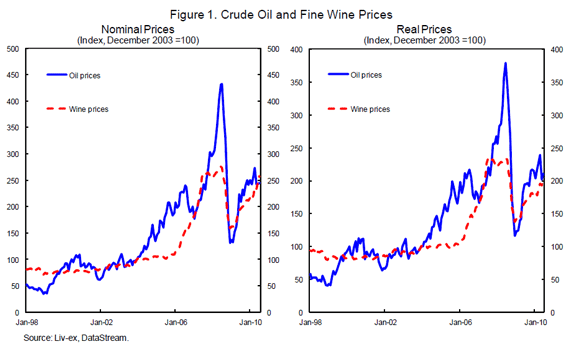What Wine Prices Tell Us About OPEC
More on:
What do oil and wine have in common? A new working paper from two IMF economists, which is generating a lot of buzz, argues that they’re a lot more alike than you’d imagine. (Hat tip: Steve LeVine.) The authors look at the prices of crude oil and fine wine between 1998 and 2010 and show that they’re highly correlated. They find that that’s because they’re both driven primarily by demand – in particular, they argue that surging global economic growth over the period they’ve studied explains a huge fraction of the movement in both wine and oil prices. Supply constraints, on the other hand, seem to play at most a bit role.

That’s provoked a reaction over at the Wall Street Journal:
“The working paper buries the long-held view that OPEC can move prices up and down solely by turning spigots on and off. Dead are the days of the oil shocks of the 1970s when blockades and revolutions threw wealthy economies into disarray. Long live the demand shocks where price hikes are mainly driven by the roaring engine of fast-industrializing nations.”
Not so fast. There are two big problems with this argument. Thinking through them helps us understand a bit about how OPEC and oil markets might work.
First, while I have no doubt that OPEC is often far less influential than many assume, the study mashes together several periods in a way that makes it very difficult to draw conclusions about the impact of supply on prices. It’s quite possible to argue that a supply glut made OPEC relatively powerless in the late 1990s; OPEC then became quite influential (in keeping prices up) for a few years at the beginning of the 2000s; then OPEC lost control (while trying to hold prices down) through the later part of the spike; and, finally, OPEC started exerting upward pressure on prices again in the last couple years of the decade. (When I say “OPEC”, I don’t mean to imply that the group necessarily functions effectively as a cartel; Saudi market power means that OPEC can often influence prices without effective collusion.) The impact of this type of inconsistent behavior may be difficult to detect using the approach in the paper.
Second, the wine analogy is severely flawed. Here’s the Journal again:
“[The authors] reached their conclusion after finding that fine wine prices—measured in an index of 24 Bordeaux chateaux–moved alongside crude oil in the past decade. Unlike OPEC for oil, no international producers’ group of stature exists for fine red.”
Here’s the thing: Oil supply should be responsive to price. The supply of fine wine, on the other hand, probably should not be. Take a look at the wines that make up the fine wine index that the IMF authors use: they’re mostly from 5-20 year old vintages. You can’t conjure more 1990 Latour simply because Chinese demand is surging today. If both oil and wine prices behave similarly, then, it’s more natural to conclude that oil supply is similarly inflexible. That’s evidence in favor of oil supply being relatively unresponsive to price – and hence evidence in favor of OPEC influence.
In any case, I look forward to reading a revised version of the paper in the Journal of Wine Economics. One of its editors even knows a thing or two about oil.
More on:
 Online Store
Online Store